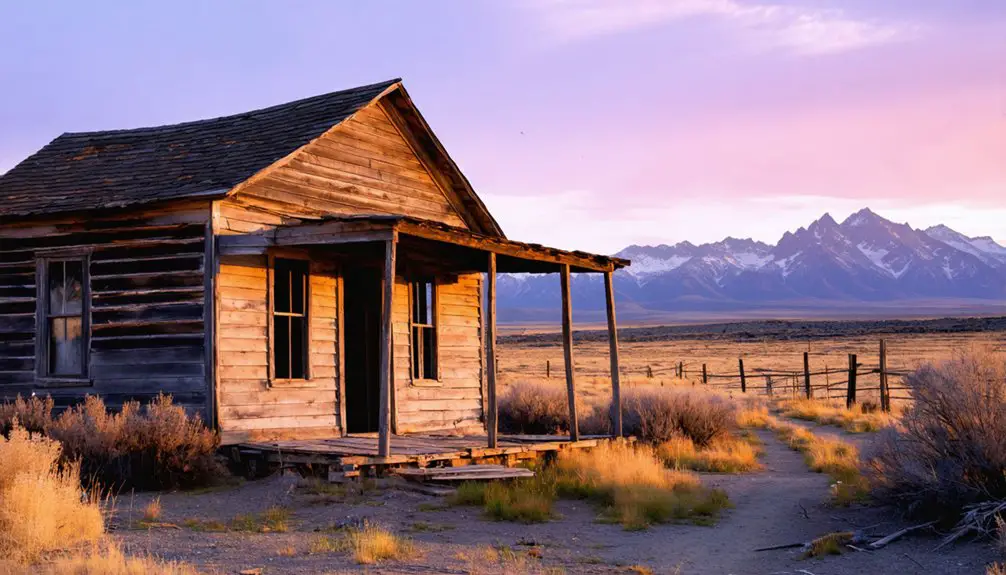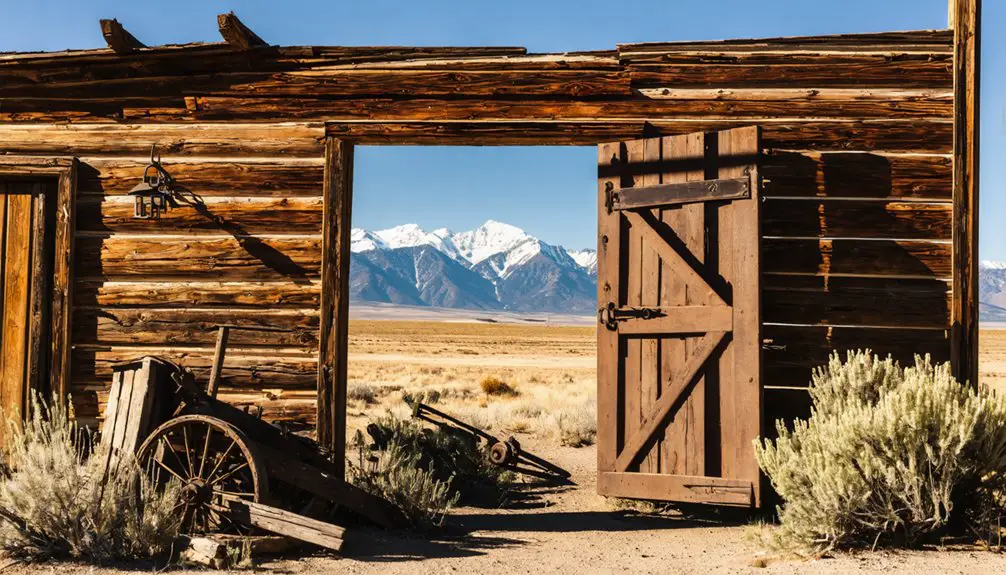You’ll find Dover’s remains in Utah, where William Robinson established this pioneering settlement in 1877 after an earlier failed attempt. The community thrived briefly with 50 homes, but faced devastating challenges from floods, droughts, and agricultural difficulties. During the Great Depression of the 1930s, economic collapse and severe environmental pressures forced residents to abandon their homes. Today, the remote ghost town’s cemetery and historical markers tell a compelling story of frontier resilience and ultimate surrender to nature’s harsh reality.
Key Takeaways
- Dover was established in 1877 in Utah under William Robinson’s leadership but later became abandoned due to economic and environmental challenges.
- The settlement reached its peak with 50 homes and basic infrastructure before declining during the Great Depression of 1933.
- Environmental challenges including floods, droughts, and dust storms severely impacted farming activities and contributed to the town’s abandonment.
- Much of Dover’s original farmland now lies beneath Yuba Reservoir, with only the cemetery remaining as a historical marker.
- The ghost town is remotely located and managed by The Church of Jesus Christ of Latter-day Saints, preserving its pioneer heritage.
The Birth of a Pioneer Settlement
While many Utah settlements emerged during the mid-1800s, Dover’s establishment came later in 1877 under William Robinson’s leadership.
You’ll find that this resettlement marked a strategic expansion of pioneer communities in previously abandoned territory, reflecting the organized approach to frontier development that characterized Mormon settlements of the era.
Under Robinson’s pioneer leadership, Dover quickly took shape with community organization at its core.
Robinson’s decisive leadership brought swift structure to Dover, establishing a well-organized pioneer community from the ground up.
You can trace the settlement’s deliberate planning through its eventual peak of 50 homes, centralized store, and supporting infrastructure.
The layout demonstrated the settlers’ commitment to creating a sustainable community despite the challenges of Utah’s arid environment.
Like Old Iron Town, the settlement’s success depended heavily on local geological resources.
This founding period exemplified the determination and resourcefulness you’d expect from late 19th-century frontier settlers establishing new roots in remote territories.
Similar to Grafton’s early years, the community faced significant challenges with irrigation and flooding that would impact its long-term sustainability.
Early Days and Community Growth
Dover’s initial development followed an unusual pattern, with a failed settlement attempt in 1875 under John E. Forsgren, who led settlers from Santaquin following “The Order of Enoch” plan.
You’ll find that the community’s true foundation emerged in 1877 when William Robinson spearheaded a more successful resettlement effort, naming the town after Dover, England.
The settler experiences shaped a modest but structured community, with roughly 50 homes at its peak.
The community was established by early homesteaders who sought to cultivate the land near the Sevier River.
You can trace the community dynamics through the establishment of essential infrastructure, including a local store and community building.
Early settlers struggled against devastating river floods that destroyed their crops.
While these developments suggested promising growth, they’d soon face significant challenges.
The town’s agricultural foundation, coupled with its lack of industrial diversity, left the settlement vulnerable to the environmental and health challenges that would later contribute to its decline.
Agricultural Life in Dover
As settlers established themselves in Dover, agricultural practices emerged that were specifically adapted to the region’s challenging environment.
You’d find farmers focusing on drought-resistant grains and potatoes while practicing crop diversity through small-scale livestock operations to guarantee survival when harvests failed. The community’s agricultural backbone depended on manual labor and animal-drawn plows, with limited mechanization available. Similar to Hawaiian farmers in Iosepa, they demonstrated remarkable resilience in cultivating crops despite harsh conditions.
Despite their resourceful livestock management strategies, including seasonal grazing rotations and maintaining essential animal products for trade, Dover’s farmers faced persistent challenges.
Periodic flooding from the Sevier River damaged fields, while disease outbreaks and harsh winters threatened both crops and livestock. Much like the fate of nearby Knightsville, Dover’s isolation and environmental difficulties proved insurmountable.
These agricultural hardships, combined with inadequate storage facilities and limited transportation infrastructure, ultimately contributed to Dover’s population decline and abandonment by 1900.
Environmental Challenges and Hardships
The harsh environmental conditions of Dover extended far beyond its agricultural challenges.
You’ll find that water management issues plagued the settlement, as persistent drought conditions and seasonal water shortages strained both farming operations and daily life. Similar challenges can be seen today as severe drought conditions affect millions of Utah residents. The presence of invasive cheatgrass significantly increased the risk of devastating wildfires in the region.
The region’s isolation amplified these hardships, with primitive roads making supply delivery and emergency assistance nearly impossible during environmental disasters.
Mining contamination left an indelible mark on Dover’s landscape, with toxic tailings and chemical residues threatening both human health and ecological stability.
You’d have encountered extreme temperature fluctuations that tested the limits of early shelters, while avalanches and rockslides posed constant dangers to infrastructure.
The combination of harsh winters, limited access routes, and degraded soil conditions ultimately contributed to the town’s vulnerability and eventual abandonment.
The Great Exodus of the 1930s
When nationwide unemployment soared to devastating levels in 1933, Dover’s already fragile economy collapsed under the weight of America’s Great Depression. Utah’s 36% unemployment rate devastated the town, as wage levels plummeted by 45% and work hours decreased by 20%. Severe drought conditions created massive dust storms that further crippled the local farming community.
The resulting economic disparity forced many residents to abandon their homes, unable to pay rent or mortgages. Many families found themselves seeking assistance from The Travelers’ Aid Society as they searched for opportunities in other regions.
The migratory trends that followed reflected the era’s desperation. You’d have seen entire families and single men joining the exodus, with most relocating within Utah or to neighboring states. Some brave souls ventured west to California, despite facing hostile anti-migrant policies.
Those who remained watched their community unravel as transient populations overwhelmed local resources, while makeshift camps and “Hoover Cafés” became stark symbols of the period’s hardships.
What Remains Today
Today’s visitors to Dover encounter only fragments of its once-vibrant community, scattered across a landscape transformed by both nature and human intervention.
You’ll find dilapidated building remains and weathered foundations that hint at the town’s former layout, while archaeological findings remain largely unexplored beneath the soil.
The Dover Cemetery stands as the most significant preserved site, featuring historical markers that commemorate the original settlers and epidemic victims.
The Church of Jesus Christ of Latter-day Saints maintains this sacred ground, which serves as the primary physical connection to Dover’s past inhabitants.
Much of the town’s former farmland now lies submerged beneath Yuba Reservoir, while the surrounding terrain shows the impact of irrigation projects and natural reclamation.
Access requires navigation through rural roads, with limited infrastructure marking this remote ghost town‘s location.
Legacy and Historical Significance

Dover’s legacy as a failed Mormon settlement offers invaluable insights into the precarious nature of frontier communities in 19th-century Utah. The town’s story exemplifies how environmental challenges, health crises, and economic hardships could overwhelm even the most determined pioneers, testing the limits of community resilience.
You’ll find that Dover’s cultural heritage lives on through its preserved cemetery, now under the stewardship of The Church of Jesus Christ of Latter-day Saints.
The settlement’s collapse serves as a stark reminder of how frontier communities could succumb to the combined pressures of agricultural failure, disease outbreaks, and environmental degradation.
Frequently Asked Questions
Are There Any Paranormal or Ghost Stories Associated With Dover’s Ruins?
Like an empty stage without actors, you won’t find documented haunted happenings at Dover’s ruins. While Utah’s ghost towns often spark ghostly encounters, there’s no verified paranormal activity specific to Dover.
What Happened to the Personal Belongings Left Behind by Dover Residents?
You’ll find most abandoned possessions were either moved with relocating families, salvaged over time, or destroyed by exposure. Those remaining lost their historical significance as structures deteriorated and scavengers took items.
Did Any Families Return to Dover After the Mass Exodus?
Like a locked door to the past, you won’t find evidence of Dover families making permanent return visits. Historical records show the mass exodus by 1900 marked a final, complete abandonment.
Are There Still Living Descendants of Dover’s Original Settlers Today?
You’ll find living descendants today, though they’re scattered across Utah and beyond. While descendant interviews and family histories suggest continued lineages, no thorough study has confirmed exact numbers.
Can Visitors Legally Explore and Photograph Dover’s Remaining Structures?
You’ll need explicit permission due to legal restrictions, as Dover’s structures likely sit on private property. Don’t risk trespassing charges – verify ownership and follow photography guidelines before exploring remains.
References
- https://onlineutah.com/doverhistory.shtml
- https://www.youtube.com/watch?v=AoiIha-3iNo
- https://www.ksl.com/article/51362209/how-the-past-lingers-in-these-utah-ghost-towns
- https://jacobbarlow.com/2020/02/13/dover-utah/
- https://en-academic.com/dic.nsf/enwiki/9496573
- https://www.utahlifemag.com/blog/post/4-ghost-towns
- https://www.ksl.com/article/46773993/visit-these-6-fascinating-utah-ghost-towns-this-summer-and-keep-your-social-distance
- https://www.visitutah.com/things-to-do/history-culture/ghost-towns
- https://www.grandcountyutah.net/388/Ghost-Towns-Communities
- https://www.deseret.com/utah/2024/06/03/how-to-visit-utah-ghost-towns/



